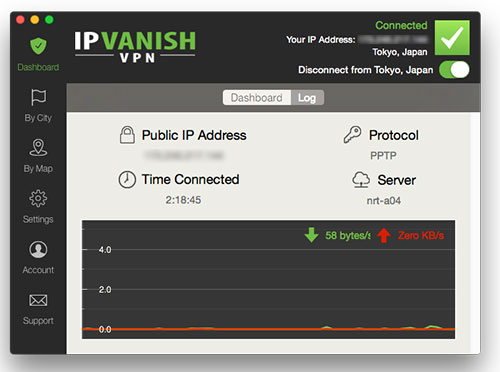

You should now see lots of files and folders who’s name starts with “.” become visible. Click on Macintosh HD, or whatever you’ve called your startup drive if you’ve renamed it.Open a new Finder window and click on the name of your Mac under ‘Devices’ in the sidebar.If you still want to view hidden files on your Mac, you need to go to the Finder and do the following: CleanMyMac X scans your Mac, identifies this system junk and allows you to quickly and easily get rid of it, potentially several gigabytes of disk space. They just sit there clogging up your hard drive. Many of these files are created and used then not needed anymore.
#IPVANISH FOR MAC 10.6 FOR FREE#
You can download CleanMyMac X for free here.ĬleanMyMac X will also allow you to get rid of all the hidden files you no longer need. That will make it easy to remove all the files associated with an application with one click. If your goal in viewing, for example ~/Library is so you can manually delete application support files for a program you’ve uninstalled, consider using a dedicated uninstaller like CleanMyMac X. The data they contain could cause havoc if you delete or alter it and don’t know what you’re doing. Also, if they were all visible, your Mac would look horribly cluttered.īefore you make your Mac show hidden files, it’s important to remember they’ve been hidden for a reason. In addition, there’s no real reason for most users to see or access them. Mostly, though, it’s because they contain data critical to the smooth running of your Mac and that you shouldn’t interfere with. There are a number of reasons files and folders are hidden. The files themselves contain data like access rights and privileges for files and folders, application support files, and preferences. For that reason, you can’t use a “.” at the start of a regular file name, otherwise OS X will hide it. In fact, the convention of naming them starting with a “.” comes from Unix. The hidden files are a throwback to macOS’ Unix roots.

In this article, we’ll tell you how you can view hidden files on your Mac and make your Library folder visible.

Both these Library folders are hidden, but inside them are folders and files that hold things like preferences for apps. Many of these files are in your Mac’s main Library folder or in the ~/Library folder, which is in your User folder. Once IPVanish has been copied to our Applications folder, it is installed and ready to use. To run IPVanish for the first time, we need to find IPVanish VPN in our Applications folder and double-click it to open it. These files and folders are all supposed to be there. Thousands of them in fact, in the form of hidden files and folders lurking on its hard drive or SSD. Open to your User's Home folder - /users/yourname/ - then either View Menu Show View Options or Cmd ⌘ J Check the box for Show Library Folder. This is simplest if you use Icon or List view. Addresses a cropping issue with some postscript printing in landscape page orientation.App updates: The Mac App Store keeps track of all your purchased apps and notifies you when free updates are available.
#IPVANISH FOR MAC 10.6 INSTALL#
Apps install in one step and are quickly available from the Dock. Buy and install: Easily purchase apps with your iTunes account.Discover Mac apps: Browse featured apps, top charts, and categories, or search for something specific.The Dock included a new Mac App Store with the following features:


 0 kommentar(er)
0 kommentar(er)
